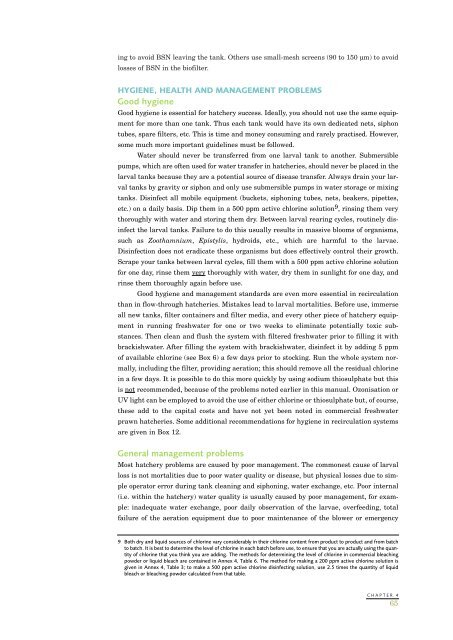You also want an ePaper? Increase the reach of your titles
YUMPU automatically turns print PDFs into web optimized ePapers that Google loves.
ing to avoid BSN leaving the tank. Others use small-mesh screens (90 to 150 µm) to avoidlosses of BSN in the biofilter.HYGIENE, HEALTH AND MANAGEMENT PROBLEMSGood hygieneGood hygiene is essential for hatchery success. Ideally, you should not use the same equipmentfor more than one tank. Thus each tank would have its own dedicated nets, siphontubes, spare filters, etc. This is time and money consuming and rarely practised. However,some much more important guidelines must be followed.Water should never be transferred from one larval tank to another. Submersiblepumps, which are often used for water transfer in hatcheries, should never be placed in thelarval tanks because they are a potential source of disease transfer. Always drain your larvaltanks by gravity or siphon and only use submersible pumps in water storage or mixingtanks. Disinfect all mobile equipment (buckets, siphoning tubes, nets, beakers, pipettes,etc.) on a daily basis. Dip them in a 500 ppm active chlorine solution 9 , rinsing them verythoroughly with water and storing them dry. Between larval rearing cycles, routinely disinfectthe larval tanks. Failure to do this usually results in massive blooms of organisms,such as Zoothamnium, Epistylis, hydroids, etc., which are harmful to the larvae.Disinfection does not eradicate these organisms but does effectively control their growth.Scrape your tanks between larval cycles, fill them with a 500 ppm active chlorine solutionfor one day, rinse them very thoroughly with water, dry them in sunlight for one day, andrinse them thoroughly again before use.Good hygiene and management standards are even more essential in recirculationthan in flow-through hatcheries. Mistakes lead to larval mortalities. Before use, immerseall new tanks, filter containers and filter media, and every other piece of hatchery equipmentin running <strong>freshwater</strong> for one or two weeks to eliminate potentially toxic substances.Then clean and flush the system with filtered <strong>freshwater</strong> prior to filling it withbrackishwater. After filling the system with brackishwater, disinfect it by adding 5 ppmof available chlorine (see Box 6) a few days prior to stocking. Run the whole system normally,including the filter, providing aeration; this should remove all the residual chlorinein a few days. It is possible to do this more quickly by using sodium thiosulphate but thisis not recommended, because of the problems noted earlier in this manual. Ozonisation orUV light can be employed to avoid the use of either chlorine or thiosulphate but, of course,these add to the capital costs and have not yet been noted in commercial <strong>freshwater</strong>prawn hatcheries. Some additional recommendations for hygiene in recirculation systemsare given in Box 12.General management problemsMost hatchery problems are caused by poor management. The commonest cause of larvalloss is not mortalities due to poor water quality or disease, but physical losses due to simpleoperator error during tank cleaning and siphoning, water exchange, etc. Poor internal(i.e. within the hatchery) water quality is usually caused by poor management, for example:inadequate water exchange, poor daily observation of the larvae, overfeeding, totalfailure of the aeration equipment due to poor maintenance of the blower or emergency9 Both dry and liquid sources of chlorine vary considerably in their chlorine content from product to product and from batchto batch. It is best to determine the level of chlorine in each batch before use, to ensure that you are actually using the quantityof chlorine that you think you are adding. The methods for determining the level of chlorine in commercial bleachingpowder or liquid bleach are contained in Annex 4, Table 6. The method for making a 200 ppm active chlorine solution isgiven in Annex 4, Table 3; to make a 500 ppm active chlorine disinfecting solution, use 2.5 times the quantity of liquidbleach or bleaching powder calculated from that table.CHAPTER 465
















